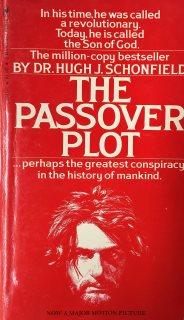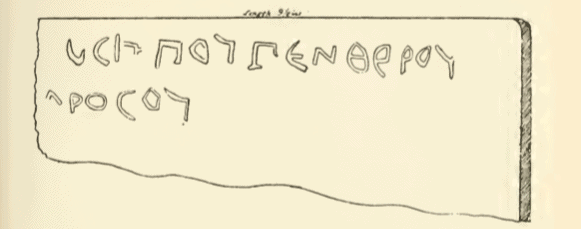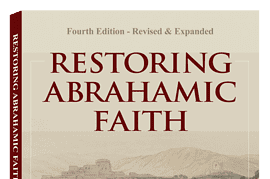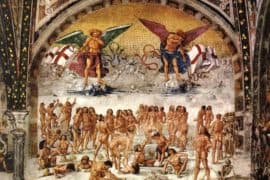 I am sure many of my older readers will remember Hugh J. Schonfield’s , 1965 blockbuster international best seller, The Passover Plot, now re-released in a special 40th anniversary edition. Schonfield was somewhat of a “maverick” independent scholar, well trained but never pursing an academic university career, but publishing dozens of books that remain of great value. Many are out of print though several of his main works have been brought back into circulation by his literary executor, Stephen A. Engelking. One of these works, According to the Hebrews: A New Translation of the Gospel According to the Hebrews(1937) has the following rather fascinating observation on the elusive “Pantera,” reputed biological father of Jesus of Nazareth. If you are not familiar with the work I have done in the past on the Pantera traditions, you can search for “Pantera” on my blog or follow this link. Here is a summary of Schonfield’s interpretation by my former graduate student Chad Day:
I am sure many of my older readers will remember Hugh J. Schonfield’s , 1965 blockbuster international best seller, The Passover Plot, now re-released in a special 40th anniversary edition. Schonfield was somewhat of a “maverick” independent scholar, well trained but never pursing an academic university career, but publishing dozens of books that remain of great value. Many are out of print though several of his main works have been brought back into circulation by his literary executor, Stephen A. Engelking. One of these works, According to the Hebrews: A New Translation of the Gospel According to the Hebrews(1937) has the following rather fascinating observation on the elusive “Pantera,” reputed biological father of Jesus of Nazareth. If you are not familiar with the work I have done in the past on the Pantera traditions, you can search for “Pantera” on my blog or follow this link. Here is a summary of Schonfield’s interpretation by my former graduate student Chad Day:
Schonfield (According to the Hebrews, 142-50) offers an intriguing explanation which dovetails nicely with Tabor’s discussion of Luke’s genealogy (The Jesus Dynasty, 48-56) and also avoids any alleged wrongdoing on the part of Mary. Passing over the putative philological rationalization of Pandera as an Aramaic transliteration of the Greek Panthēra, Schonfield takes Panthera as a family name, stemming from the great-grandmother of Jesus: Estha who, upon the death of Matthan (Matthew’s genealogy; or Matthat in Luke’s), married a Syrian convert to Judaism by the name of Melchi, from the family Panthera (cognomen). So, for Schonfield, this matches both the reference in Epiphanius and John of Damascus of a Barpanther. This also places Jesus in the line of Nathan. Schonfield argues that, since Jesus’ (northern Gentile) heritage would have been frowned upon, many Jewish opponents began calling him by his family name instead of Jesus the Nazarene.
Schonfield adduces two texts for support of his hypothesis:1) b. Sanh. 106a – “…she came of rulers and princes, but she prostituted herself for carpenters” (noting the confusion over the correct generation during which this Gentile blood came into Jesus’ line);
2) Teaching of Jacob (634 CE) – “…she is the daughter of David and not Theotokos, for Mary is a woman, daughter of Joakim, and her mother was Anna. Now Joakim is son of Panther, and Panther was brother of Melchi, as the tradition of us Jews in Tiberias has it, of the seed of Nathan, the son of David, of the seed of Judah.”
Here we find an explanation (albeit speculative) that undermines the Parthenos Pun without recourse to an illegitimate birth of Jesus by a certain Panthera (Roman soldier or not).
My own research on the entire Pantera tradition is leading me more and more in these directions, namely that Pantera is indeed a family name, part of the line of Mary, that traced it’s ancestry to King David, but through Nathan, also a son of Bathsheba, younger brother of Solomon. I will include a full discussion of this in my forthcoming new book, The Lost Mary: How the Jewish Mother of Jesus Became the Virgin Mother of God (Knopf, 2020) which will be available next year.
Part of that evidence is a little known fragment of an inscribed ossuary, whereabouts now unknown, identified in 1891 by Clermont-Ganneau based on a squeeze in his possession. It came from a tomb on Nabulus Road, just north of the Old City of Jerusalem (See Clermont-Ganneau, “Notes on Hebrew and Jewish Inscriptions,” PEFQS 23 (1891)242-43). It is not part of the Israel State Collection and so far as I can tell, without an index, the inscription is not listed in Corpus Inscriptionum Iudaeae/Palesestinae. So far I have not been able to locate it though I am told that most of Clermont-Ganneau’s inscriptions were either sent to the Palestine Exploration Fund or the Lourve in Paris. It is recorded in Corpus Inscriptionum Judaicarum # 1211. The inscription, based on a squeeze in the possession of Clermont-Ganneau, reads:
[ιω]σηπου πενθερου [δρ]οσου
[Iō]sepou pentherou [Dr]osou

Clermont-Ganneau took the middle “name” to be a family designation for father-in-law, or son-in-law, or brother-in-law, and thus read it as: Of Joseph, father-in-law of Drosus(?), taking the 3rdname as an ordinary transcription of the common Roman name Drusus, adopted by Jews in the period (see Josephus Antiquities18.132; דרוא ,דרוסהy. Yoma 4: 41d; y. Shabbat 1: 4a)
Tal Ilan (Lexicon of Jewish Names in Late Antiquity, p. 301) disagrees and interprets πενθεροςas the only example we have found in Palestine of the Greek name Pentheros = Panthera, otherwise found in Latin inscriptions and Greek and Aramaic sources, some of which give as the name for the father of Jesus. Assuming Tal Ilan is correct, and that we have three names, not two, all in the genitive case, it reads:
[the ossuary] Of Joseph Panthera….of Drosus (?)
Or, alternatively:
[the ossuary] Of Joseph [who is] son of Panthera…of Drusus(?)
Given that we have a 1st c. BCE/CE Jewish ossuary in Jerusalem with the name Joseph (son of/brother of) Pantera, and early Christian traditions that understand the name “Pantera” as a family name of either Joseph or Mary, what might we most likely conclude? Whatever else we might say of Jesus’ father, this mysterious “Pantera,” whether Roman soldier or not, was likely part of, or at least related to, the family. This changes rather drastically the more common “Pantera” scenario, that posits the father of Jesus as an alien figure, completely removed from the family, who somehow forced his way into the world of Jesus’ mother Miriam–by rape or seduction.
With regard to Schonfield, although I do not agree with the main thesis of his most famous book, The Passover Plot, namely, that Jesus never actually died and was revived in the tomb after the crucifixion, his lifelong work on Christian Origins, in a dozen books, plus his truly amazing translation of the New Testament (The Authentic New Testament, also sadly out of print), I greatly value. My favorite of them all is Those Incredible Christians, but all of his works, from the 1930s on, are of incredible value. I have collected them all over the years, even in the out of print editions. There is a nice summary with many links of his work at Wikipedia.
I should also mention a personal note here. I corresponded with Hugh Schonfield in the last years of his life, in the 1970s. I was a beginning graduate student at the University of Chicago and he was the seasoned and most famous scholar, but he wrote me long handwritten letters which I treasure to this day, generously offering me research ideas and feedback on my work on Paul which became my dissertation. He had given away all of his money to charitable causes and the idea to which he was most committed was laid out in his last book, The Politics of God (1972). Dr. Schonfield became fired with the possibilities of applying the ancient Messianic ideal of a “Servant nation” to the modern world. He formed what was called the Mondcivitan Republic, or “The Commonwealth of World Citizens,” the remnants of which now survive him in the work of Hugh and Helene Schonfield World Service Trust. I highly recommend a bit of browsing at this most interesting and cause-worthy site.








Comments are closed.